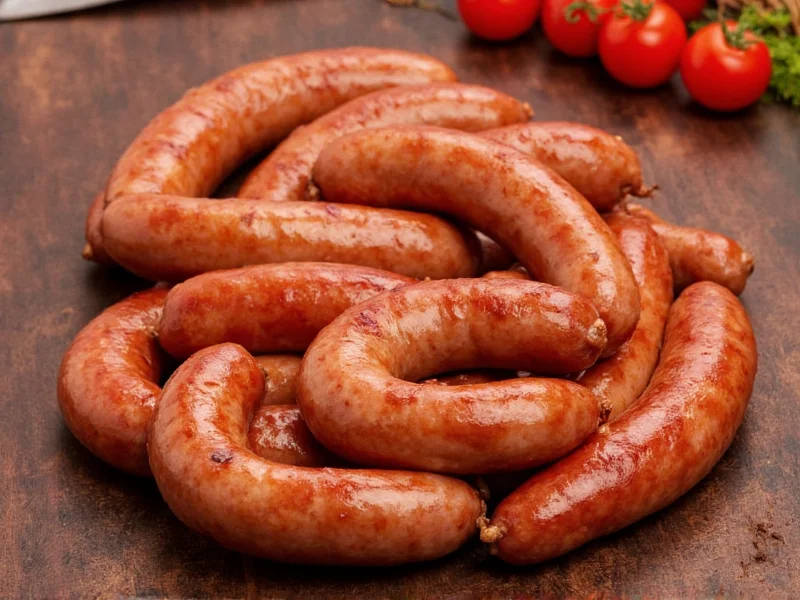Understanding the proper cooking temperature for sausages isn't just about achieving perfect doneness—it's a critical food safety requirement. Many home cooks rely on visual cues like color or texture to determine if sausages are cooked, but these methods can be dangerously misleading. The only reliable way to ensure your sausages are safe to eat is by using a food thermometer to verify they've reached the appropriate internal temperature.
Why Temperature Matters for Sausage Safety
Sausages present unique food safety challenges compared to whole cuts of meat. Because they're made from ground meat, any bacteria present on the surface gets distributed throughout the product during processing. This means sausages require thorough cooking to eliminate potential pathogens like Salmonella, E. coli, and Trichinella spiralis.
The United States Department of Agriculture (USDA) and food safety experts universally recommend using a food thermometer rather than visual indicators. Research shows that color alone cannot reliably indicate doneness—pork sausages can appear browned at temperatures as low as 140°F (60°C), well below the safe minimum.
Temperature Guidelines by Sausage Type
Different sausage varieties require specific temperature targets based on their meat composition. Here's a comprehensive reference:
| Sausage Type | Safe Internal Temperature | Resting Time After Cooking |
|---|---|---|
| Pork, Beef, Lamb Sausages | 160°F (71°C) | 3 minutes |
| Chicken & Turkey Sausages | 165°F (74°C) | 3 minutes |
| Pre-cooked Smoked Sausages | 140°F (60°C) | None required |
| Vegetarian Sausages | 165°F (74°C) | 3 minutes |
Proper Thermometer Technique for Sausages
Simply owning a meat thermometer isn't enough—you must use it correctly to get accurate readings. Follow these professional techniques:
- Insert at the thickest point - Position the thermometer probe into the center of the sausage, avoiding contact with the cooking surface or bone
- Check multiple sausages - Test several sausages in a batch since cooking can be uneven
- Wait for stabilization - Keep the thermometer in place for 10-15 seconds until the reading stops changing
- Clean between uses - Sanitize the probe with hot, soapy water when checking different raw meats
Digital instant-read thermometers provide the most accurate results for sausage cooking. Dial thermometers often lack the precision needed for small diameter foods like sausages. For best results, calibrate your thermometer regularly using the ice water (32°F/0°C) or boiling water (212°F/100°C) method.
How Cooking Methods Affect Temperature Achievement
Different cooking techniques impact how evenly and quickly sausages reach safe temperatures:
Grilling: Use indirect heat after initial searing to prevent exterior burning before interior reaches safe temperature. Maintain grill temperature around 350°F (177°C).
Pan-frying: Cook over medium heat (not high) for 12-15 minutes, turning frequently. Add a small amount of water and cover for the final few minutes to ensure thorough cooking without drying.
Baking: Preheat oven to 375°F (190°C) and bake on a rack for 20-25 minutes, turning halfway through. This method provides the most even heating.
Boiling: While sometimes used for pre-cooking, boiling alone doesn't achieve proper browning. If using this method, finish on grill or in pan to reach safe temperature with desirable texture.
Common Temperature Mistakes to Avoid
Even experienced cooks make these critical errors when determining sausage doneness:
- Relying on color - Pink color can remain in properly cooked pork due to curing agents or myoglobin
- Testing too early - Checking temperature repeatedly causes heat loss and uneven cooking
- Ignoring carryover cooking - Sausages continue cooking 5-10°F after removal from heat
- Not cleaning thermometer - Cross-contamination between raw and cooked meat
- Using visual texture - Firmness varies by sausage recipe and fat content
Food Safety Best Practices
Proper temperature is just one component of sausage food safety. Follow these additional guidelines:
- Keep raw sausages refrigerated below 40°F (4°C) until ready to cook
- Never thaw sausages at room temperature—use refrigerator, cold water, or microwave methods
- Clean all surfaces and utensils that contact raw sausage with hot, soapy water
- Store leftovers within 2 hours of cooking (1 hour if ambient temperature exceeds 90°F/32°C)
- Reheat leftovers to 165°F (74°C) before consuming
Remember that proper sausage cooking temperature serves two essential purposes: eliminating foodborne pathogens and achieving the best possible eating experience. Undercooked sausages risk serious illness, while overcooked sausages become dry and unappetizing. The precise temperature targets provide the optimal balance between safety and quality.











 浙公网安备
33010002000092号
浙公网安备
33010002000092号 浙B2-20120091-4
浙B2-20120091-4